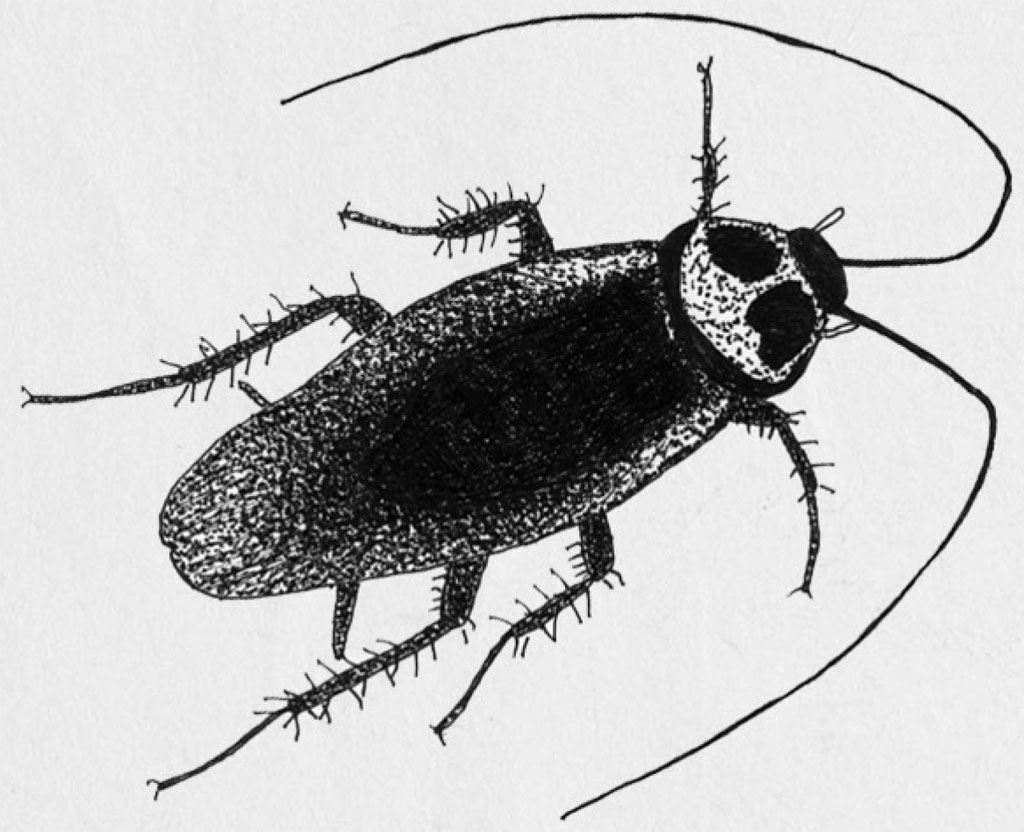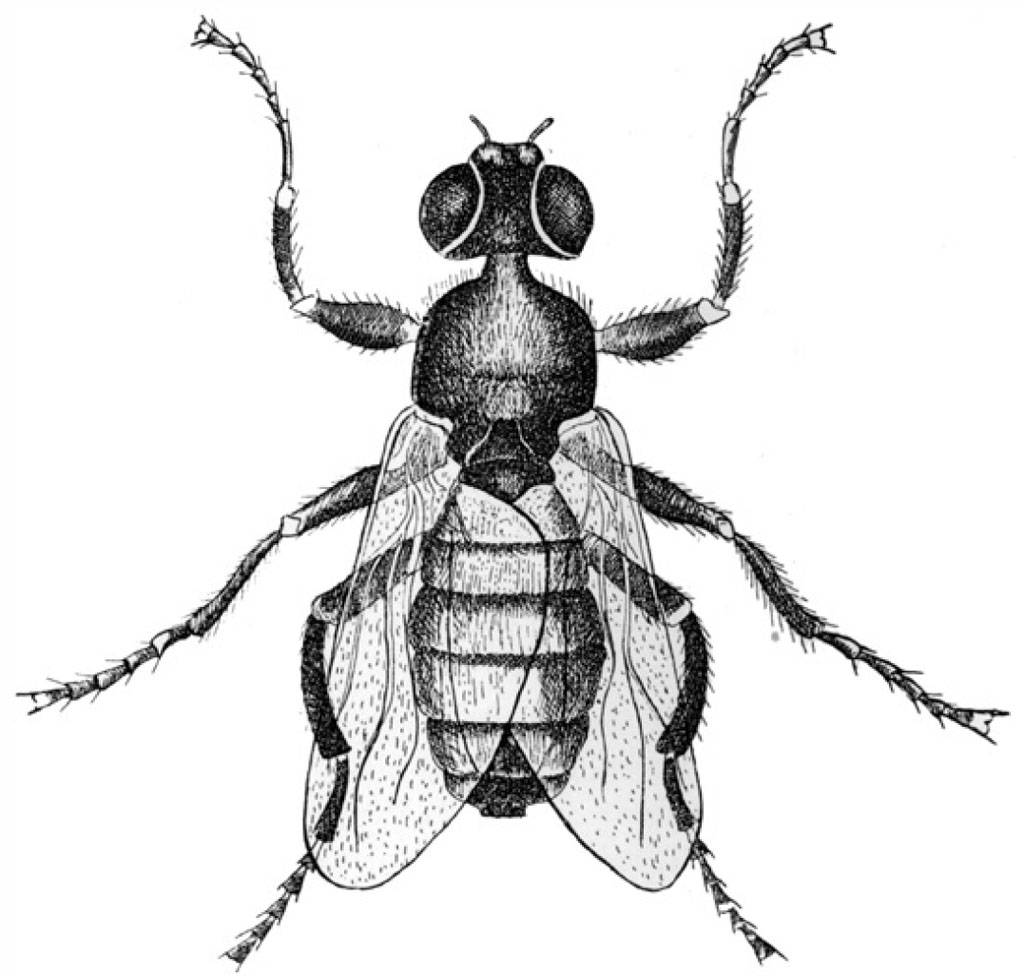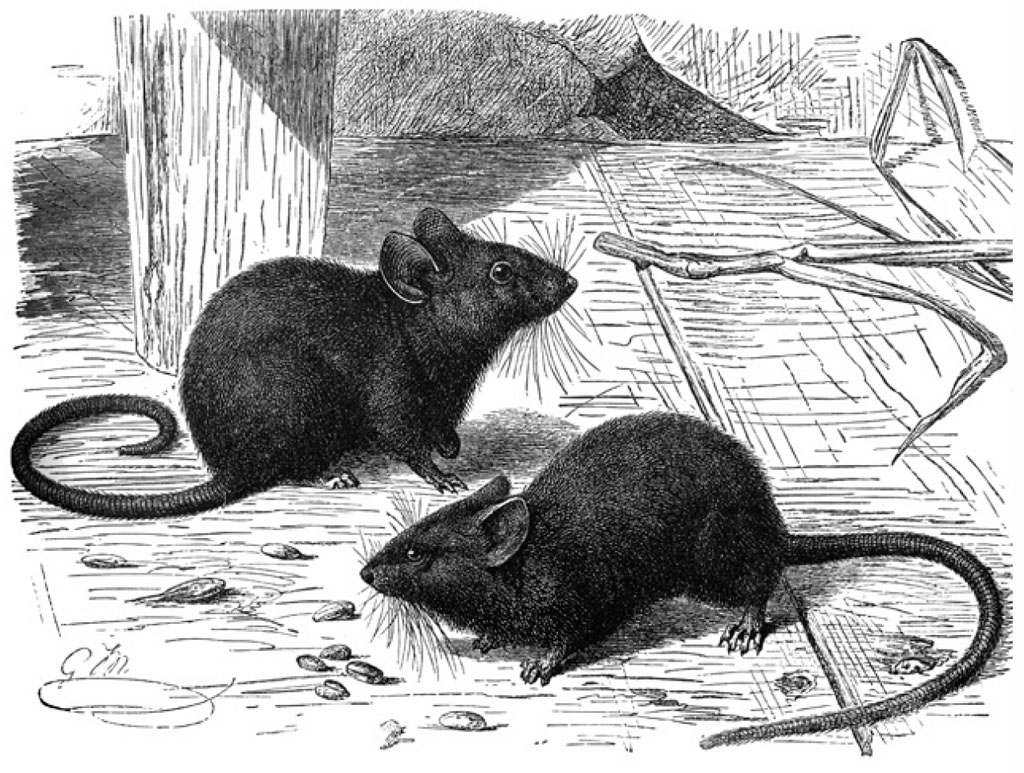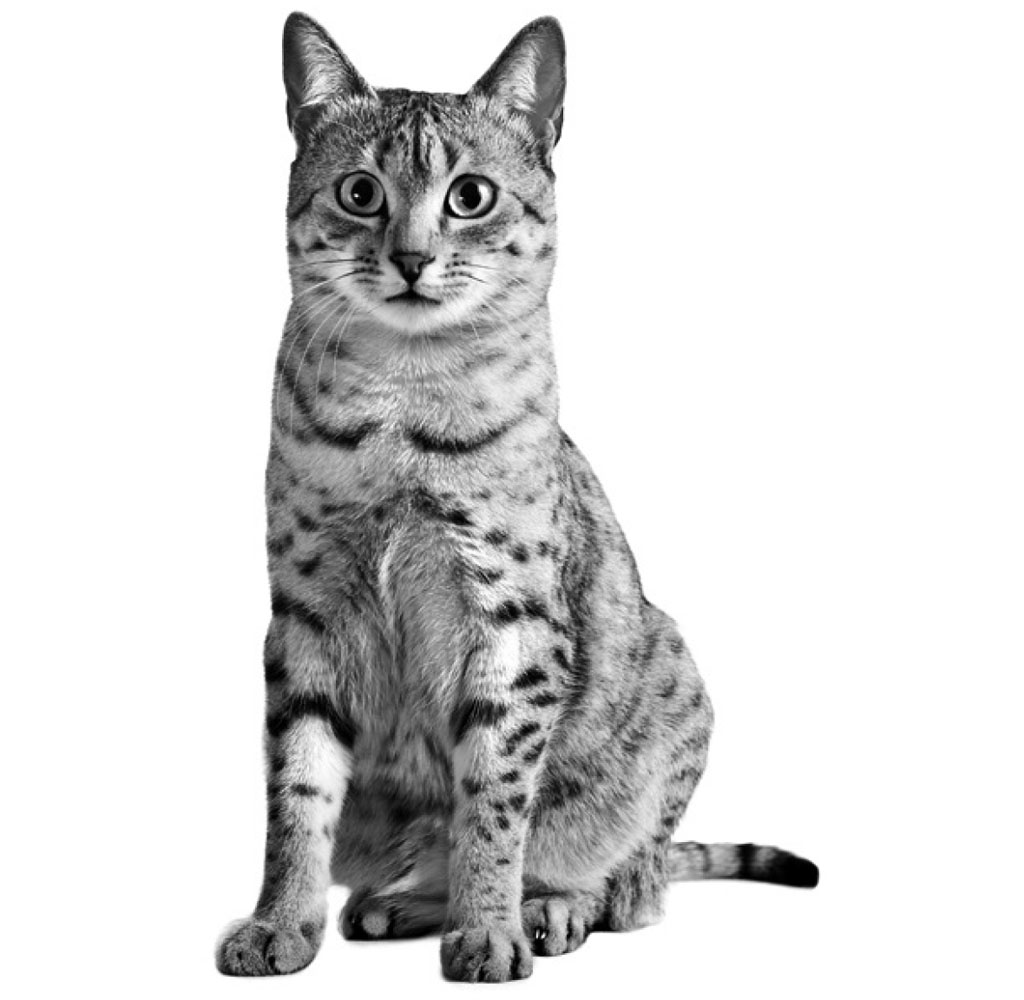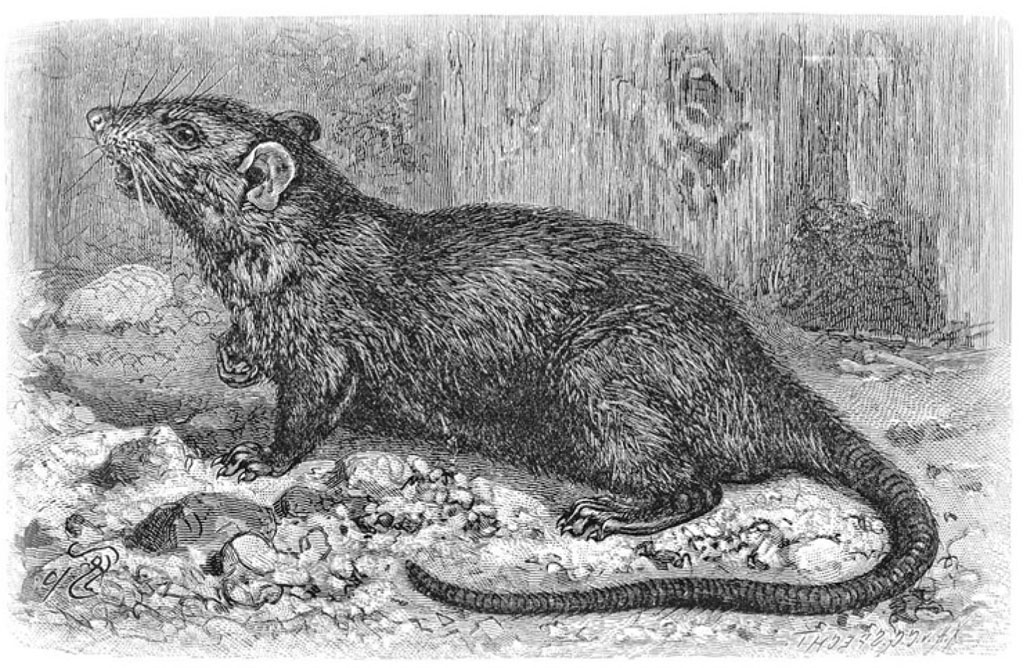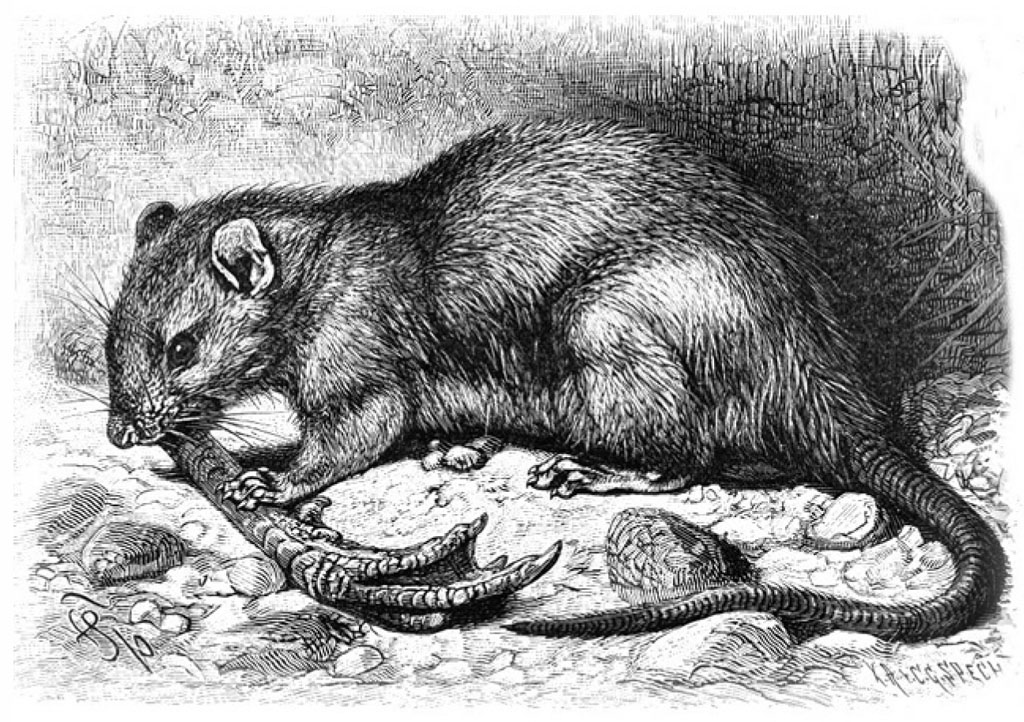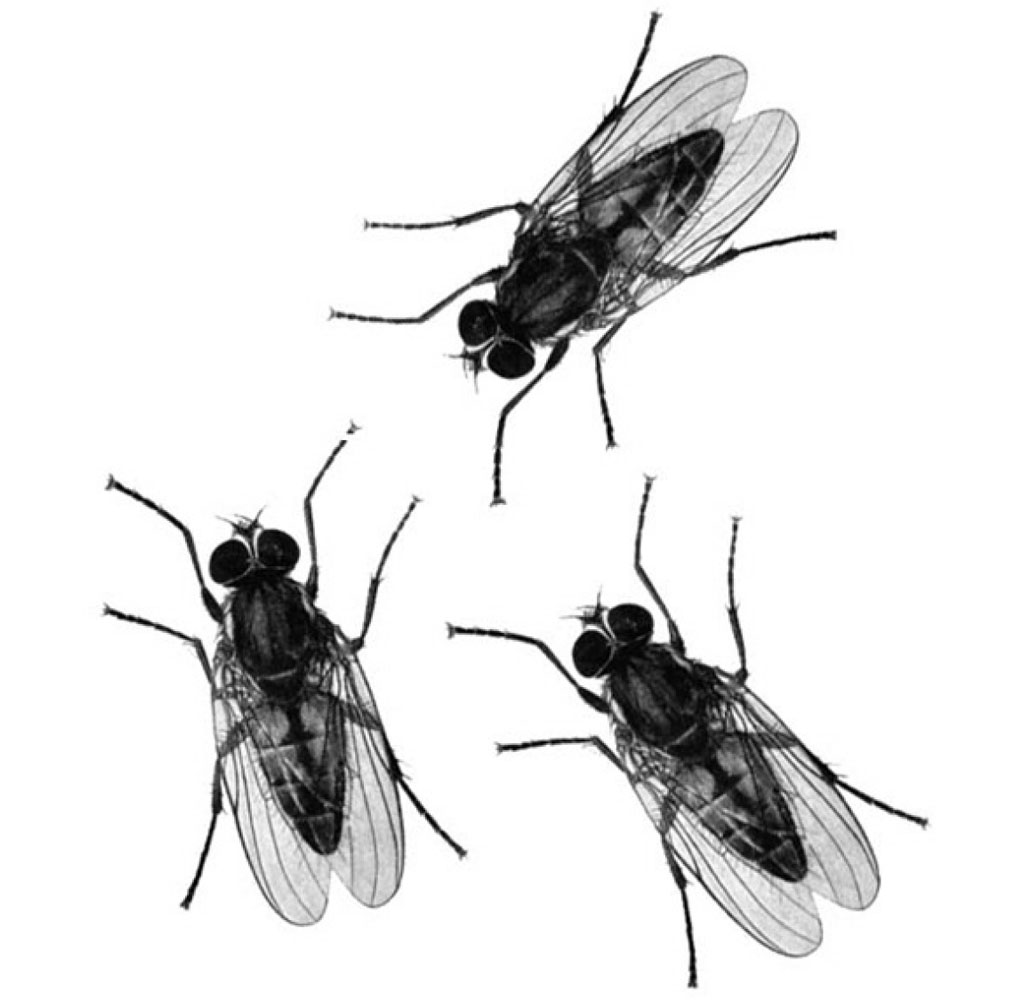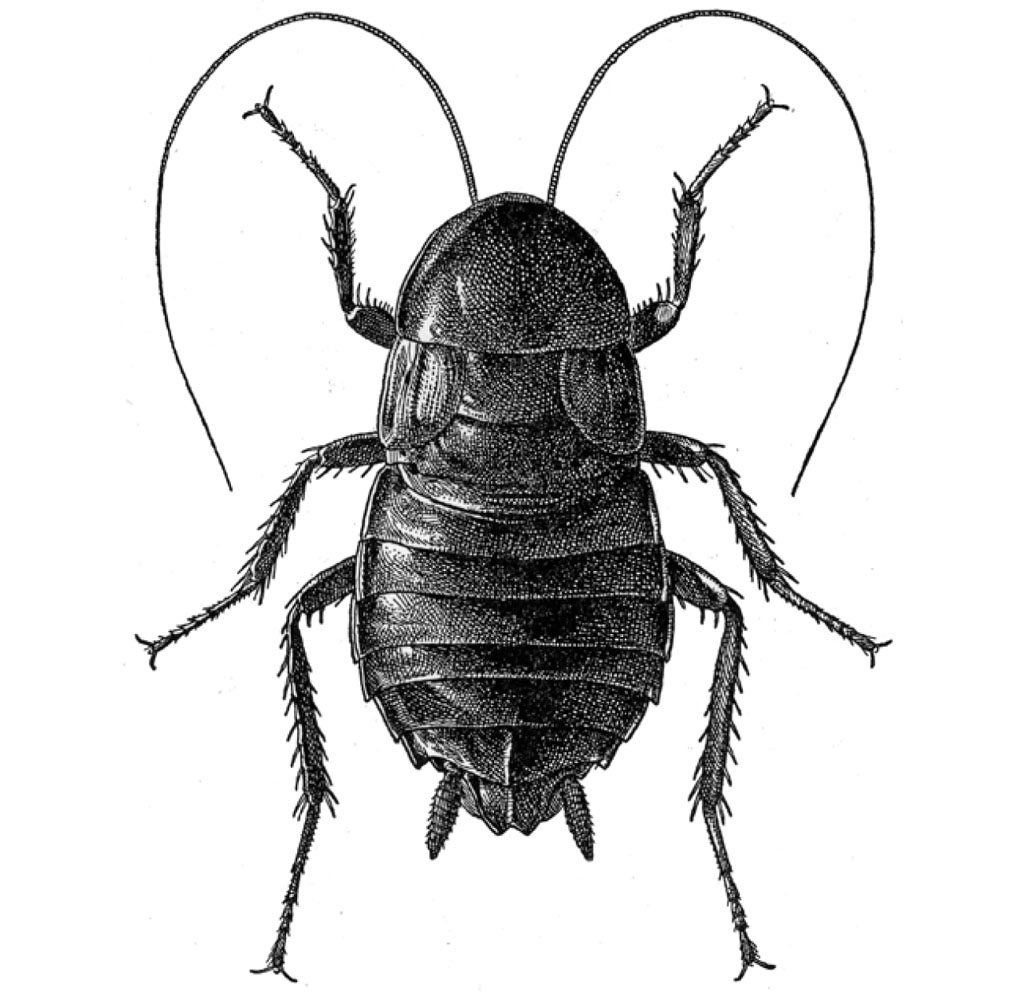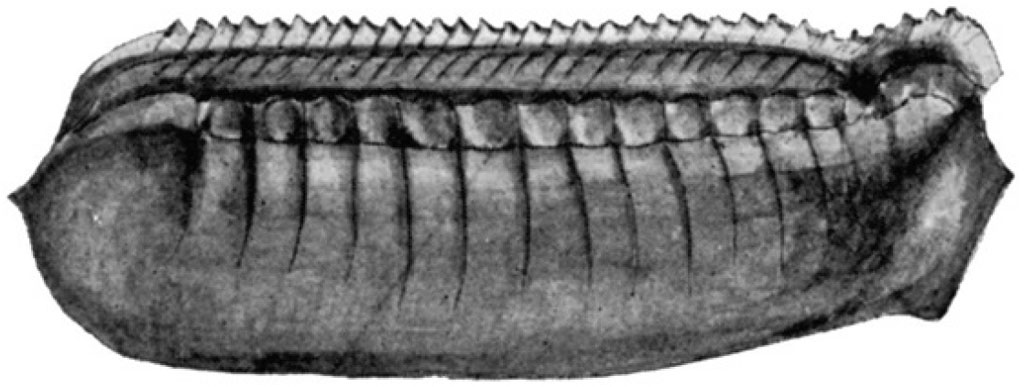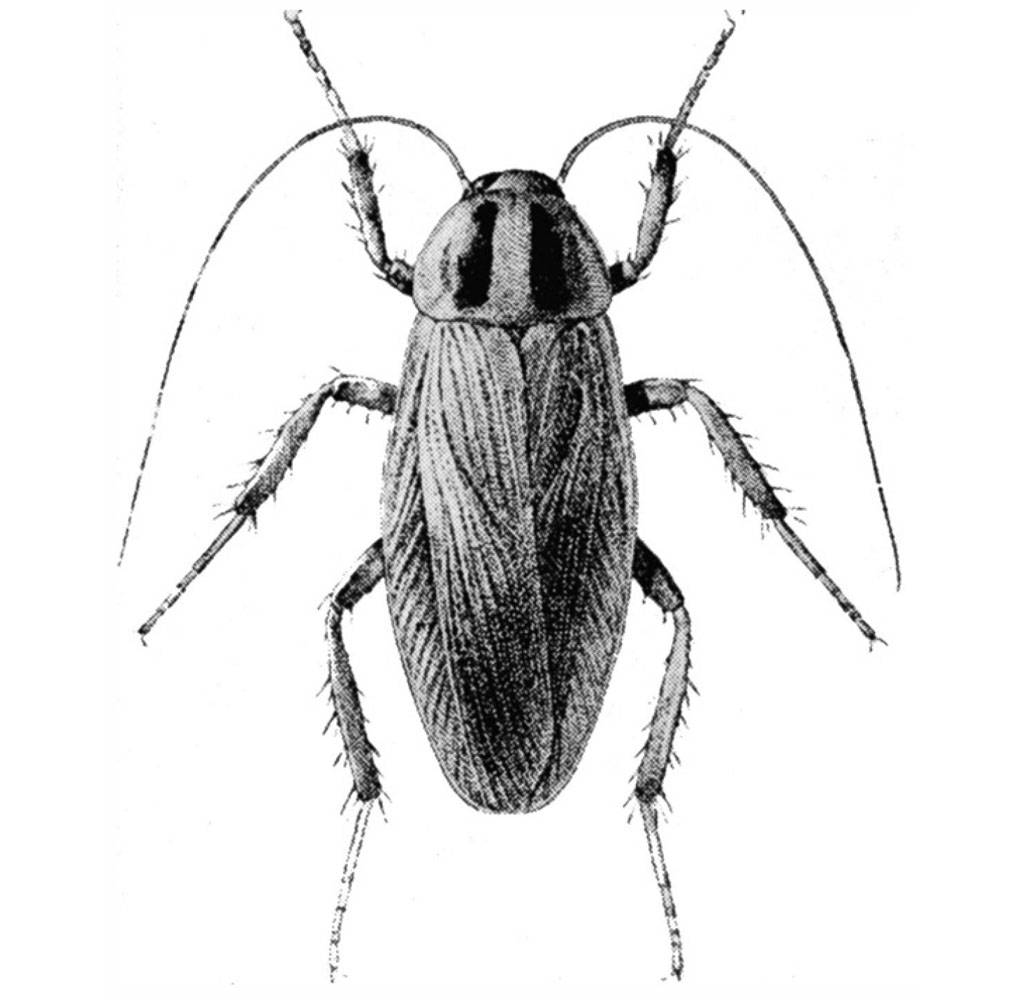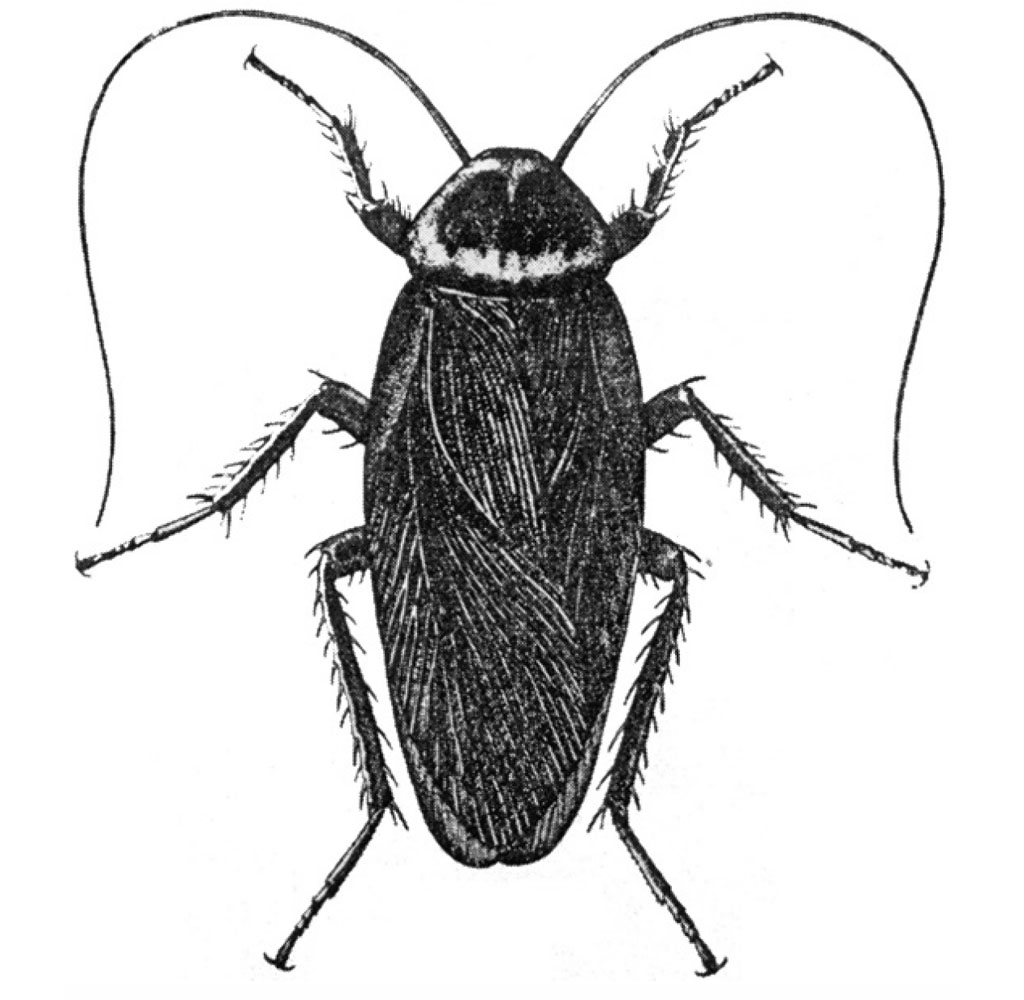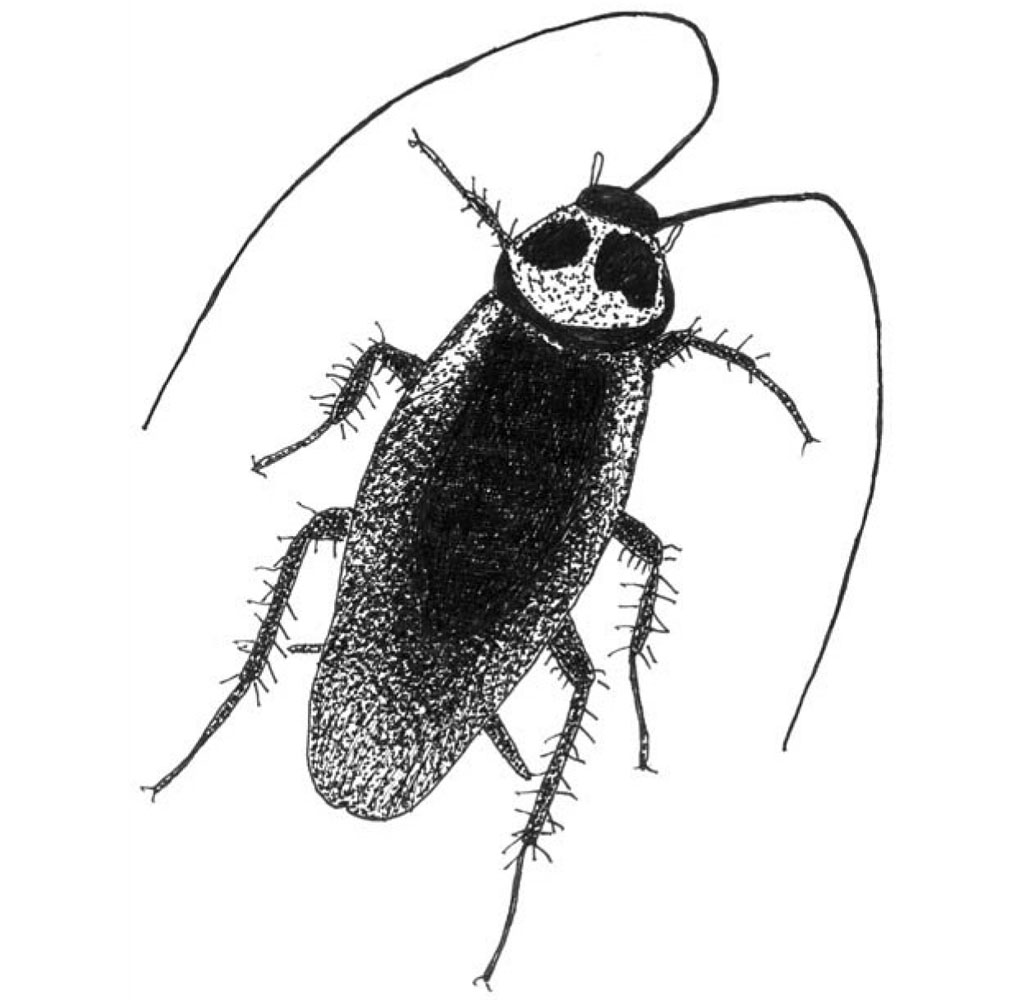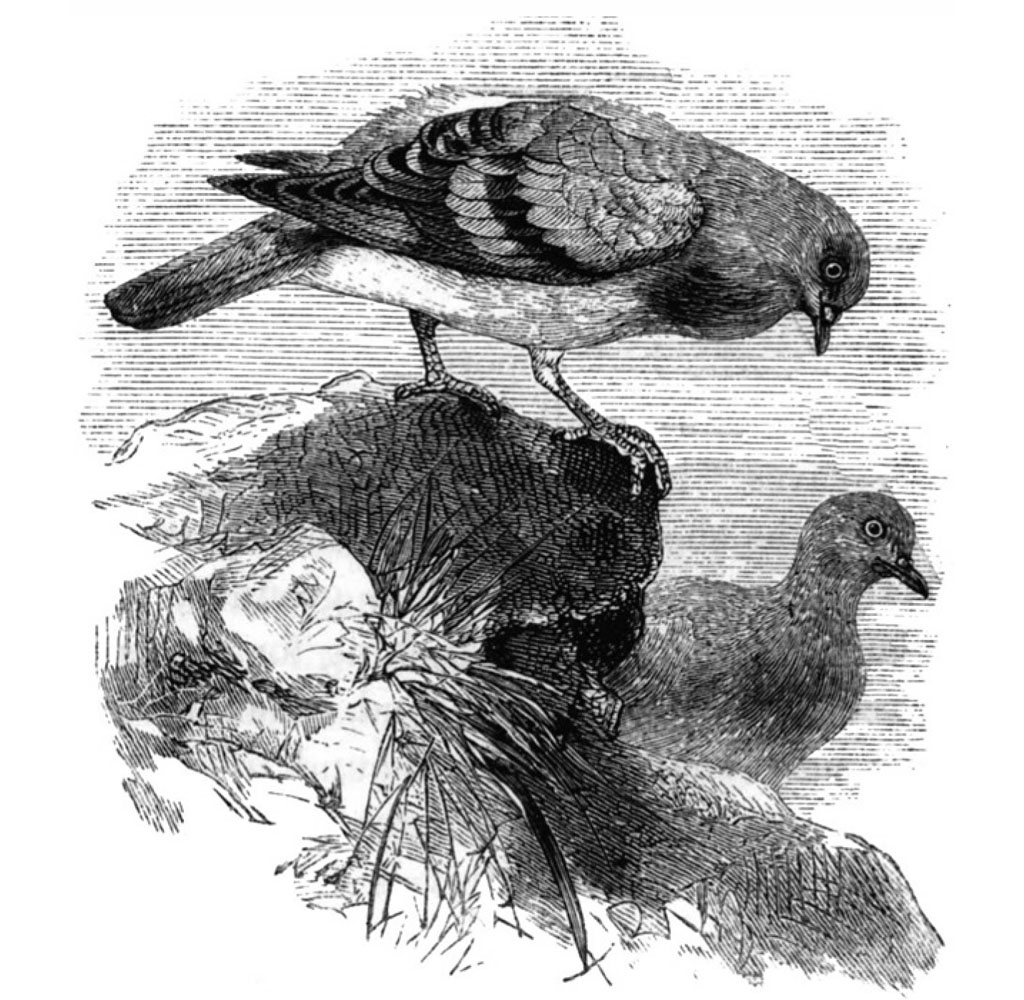MAGGOTS, DIRT, FILTH AND DROPPINGS EVERYWHERE
There is no place for animals of any kind in the modern hygienic kitchen or food store. Cats and dogs may be tolerated in domestic kitchens as long as they stay on the
floor and do not jump up on food-preparation surfaces. All other species are forbidden, by law (in the case of commercial premises like restaurants and hotels), custom or squeamishness.
Our understanding of pathogens (be they bacteria, viruses, fungi or protozoa) causing disease is only a relatively recent advance in knowledge. Until well
into the late 19th century talk of miasma, effluvia and vague malarial fogs drifting from the stench of decay, to cause outbreaks of diseases from cholera to coughing, was commonplace in general
and specialist medical textbooks. It was only with careful observation of disease spread, experimentation on diseased animals and detailed microscopy that the modern notion of germs emerged.
Suddenly, scientists realised that micro-organisms well beyond the capabilities of the human eye, and barely visible under the microscope, were causing sickness.
With this realisation emerged an understanding of how germs could be spread by sneezing and coughing, by physical contact between people, and mechanically, by an animal traipsing over our bodies
or our food. It seems strange that it took so many millennia to make this deduction. In fact this was really just the culmination of what was already an aversion to animal-soiled food.
It’s difficult to be sure what our far-distant predecessors thought about their food quality or its pollution by animals; there are no archaeological clues to tell us whether they were
horribly revolted or mildly offended. We can, however, make some educated assumptions.
NOBODY LIKES A MAGGOT – ALTHOUGH THERE ARE LEGAL REQUIREMENTS
In his quaint and curious (and I suspect slightly tongue-in-cheek) booklet Why Not Eat Insects? Vincent M. Holt (1885) suggests that the larvae of the cheese skipper
fly Piophila casei can be safely consumed since they are really all cheese inside anyway. This is one of his less outlandish suggestions; it is perhaps quite understandable why some of his
other proposals, like curried cockchafers, moths on toast and wasp grubs fried in their comb, failed to achieve culinary success.
Skipper flies get their name from the bizarre frolics of their small larvae, which can jump into the air. A larva manages this by curling over, gripping its tail in its
jaws, tensing its body muscles and suddenly releasing its bite; the flip is enough to get it 15cm airborne, and is perhaps a predator-avoidance strategy.
There are genuine stories of deliberate cheese skipper fly nurture in cheeses to produce a distinctive flavour, not to say texture; casu marzu is one such ‘rotten cheese’
from Sardinia. Today the cheese skipper fly occurs across the globe, wherever cheese is left out of the refrigerator. When it can’t find suitable cheese it lays its eggs in meat, including
ham, bacon and beef, and it has been recorded from human cadavers. Since cheese is not a natural product (in that it never occurs naturally, away from humans), this putrescent carrion lifestyle is
probably the fly’s original habitat. Indeed, rotting cheese is likely to attract all manner of normally meat-based carrion feeders.
I like cheese, and there is a tale, now infamous in Jones history, of an instance when I was forced to keep my very smelly Epoisse de Bourgogne in the small tool shed outside the back door
because it stank up the fridge too much for my nasally challenged family. A few days later I fancied some semi-liquid, creamy goo on my digestive biscuits – it took me quite a few mouthfuls
to realise that the wiggly lines I could see out of the corner of my eye were not the prelude to a migraine, but wriggling blow-fly maggots lining the inside of the packet. The grey flesh flies I
had seen resting on the shed door that week were not sunning themselves after all. They were attracted to the delicate ammonium scents from the ripe cheese – the same ammonium scents that are
given off by carrion as it reaches the semi-putrescent stage in its decay.
This is the trouble with maggots in food – they are too closely linked with decay, and a human revulsion of decaying meat is deeply ingrained. This is presumably an evolutionary hangover
from a time when pre-human scavengers on the African savannah would have done well to avoid morsels from maggoty, potentially toxic carrion. Blow flies have long been reviled
for depositing their eggs on our meat.
On the other hand, we now live in an era of ultra-squeamishness. Finding a caterpillar in a salad is no longer taken as a sign of the leaves’ freshness, but rather as an indication of poor
hygiene in the supermarket packaging department. When my two-year-old daughter and I found a fat moth caterpillar and large pellets of black frass (droppings) in a packet of basil from Israel in
the local supermarket, we were looked at askance by the groceries manager to whom I presented this find. I’m guessing we were being sized up and assessed as to whether we were likely to try
and sue the supermarket for negligence. In the end he agreed that I could have the item free of charge, so I could rear the moth in a spirit of scientific enquiry.
There was a time when there was an acceptable level of worminess in food – 10 per cent according to the Baba Batra of the Talmud, where it was decreed that if a man bought 100 figs he had
to agree to accept ten that were wormy.
‘Worm’ would have passed for almost any insect larva back in classical times, when a knowledge of pest animals was utilitarian rather than scientifically correct. We still use the
term worm very broadly today for creatures that are not true worms, in names like mealworm, woodworm, glow-worm, wire-worm (all beetle larvae), hornworm, cutworm, bollworm (moth caterpillars) and
my own particular favourite, slug-worm (sawfly larva). The next chapter looks in more detail at insect pests in stored food, where it is mainly the larvae (the ‘worms’) that do the
eating. In the meantime, it is worth contemplating the fact that worms (think tapeworm, intestinal worm, liver-worm) are deeply imbued with unpleasant connotations, so much so that they give us one
of the most powerful and momentous words we can use when describing pests – from the Latin for worm, vermis, we have vermin.
DESTRUCTION AND DROPPINGS EVERYWHERE – RODENT HUNGER AND INCONTINENCE
Mice and rats are, despite not being at all worm-like, the archetypal vermin. Today they occur so widely with humans, and so intimately with us, that it is difficult to unpick
their history from ours (Berry 1970).
One problem is that fossil and other archaeological remains are rare. Rats and mice are pretty near the bottom of the food chain, so they are usually eaten by something else long before they
have a chance to die in a place convenient for later discovery. If they do die, they are likely to be scavenged, bones, fur and all, not least by their own kind.
The earliest fossil mouse remains to date are from India 2 million years ago, and this fits with genetic and morphological studies of worldwide house mouse populations, which suggest that they
evolved from a progenitor group (named Mus linnaeusi) in the subcontinent, with the eventual appearance of the true house mouse Mus musculus in northern India and Russian
Turkestan. The earliest remains associated with humans are from southern central Europe 230,000 years ago, but these finds remain rare and enigmatic.
The arrival of human agriculture changed everything. The house mouse now started an inexorable spread around the Mediterranean seaboard, starting in about 8000 BC (Cucchi et al. 2005).
This fits in neatly with the emergence of grain farming and the rise of sea migration, trade and cultural exchange during the final throes of the Stone Age and the emergence of the Bronze Age
(roughly 4000 BC). Meanwhile house mice also spread east, reaching China and Taiwan, and into South-east Asia through the Moluccas and as far as New Guinea.
To the east house mice settled down with the rice harvest, while in the west they adapted to wheat, barley and oats. This was an easy transition from their natural foraging
habits among savannah and steppe grassland, where they made their ball-shaped nests of tightly wrapped grass stems, and ate seeds (and nuts), making small stores in and around the nests. Many wild
rodents, including the common European wood mouse Apodemus sylvaticus, continue to live like this.
We’ll come back to the niceties of cereal seeds (wild and domesticated), their types, and their harvest and storage capabilities, in the next chapter, when a whole host of other pests gets
involved with invading human stores. But remember those early Central Asian mouse prototypes, and their miniature pantries stocked with gathered seeds and nuts.
The final spurt across the whole of Europe occurred in around 1000 BC. The house mouse’s arrival in the British Isles is usually blamed, without a great deal of evidence, it has to be
said, on the Romans. Intuitively this sort of fits, not just because of Roman negligence when it came to shipboard hygiene, or vague ideas of conquering legions bringing civilisation in the form of
sophisticated farming managerial skills, but also because at about this time human population numbers in Europe, settlement sizes and imperial trade routes all conspired to make the increase and
spread of mice much easier.
The spread continued. House mice arrived in the Americas with the European adventurers during the 16th century, with stock from various Old World sites. Today in the northern USA and Canada
subspecies domesticus dominates, having arrived from northern and western Europe, while in the southern states it is replaced by subspecies brevirostris, originally from Spain,
Italy and southern France (Marshall and Sage 1981).
There is now virtually no place occupied by humans that mice have not invaded. They are recorded in deep coal mines, originally feeding on the spillings from the pit ponies, but now surviving on
crumbs of food dropped by miners. The London Underground is estimated to have half a million mice, now genetically different from their above-ground cousins, living between the tracks and eating
littered food scraps.
By a delightful serendipity the word mouse and the scientific name Mus have remained almost unchanged down the centuries, through the twists and turns of many languages, and can be
traced back to mus in Latin, to µυς (mus) in Greek and eventually to musha, from the Sanskrit word meaning ‘to
steal’. Mice certainly ‘steal’ the food they take from humans, but their greatest impact is on the food they spoil. This they do by chewing through containers, wrappers and
packages (not to mention cupboard doors and floorboards), and by scattering their copious droppings everywhere.
There is a tendency to regard mice as more nuisance than danger, but it can’t take many mouse pellets to render a loaf or packet of porridge oats unpalatable, and not many more to make it
dangerously polluted. Anything that could help prevent mouse infestation would be a godsend.
CATS – THIS ONE JUST DOMESTICATED ITSELF
The well-known feline statues of the goddess Bastet and mummified cats from Ancient Egyptian tombs have long fuelled the supposition that cats were first domesticated during the
pharaonic period about 5,000 years ago. Certainly, the pharaohs held cats in high regard, but felines had been human companions for at least 5,000 years before this. An approximately
eight-month-old cat was buried with its human owner in Neolithic Cyprus (Vigne et al. 2004).
That date, 10,000 years ago, fits in very closely with the agricultural revolution. The supposition must be that cats first came into contact with humans and were looked upon kindly because of
their mouse-hunting prowess around the Near Eastern cornfields, the granary stores or perhaps across the septic, mouse-infested midden. Genetic studies corroborate this idea.
The domestic cat is descended from the wild cat Felis sylvestris, and although it is sometimes given the scientific name Felis catus, it is usually regarded as a subspecies,
Felis sylvestris catus. True wild cats still range across Africa and Eurasia, from Scotland, through Iberia, to Namibia, Arabia, Indo-China and Mongolia, so there have
been plenty of opportunities for domestication to occur. DNA analysis of wild cats from right across their natural range identified five genetic clusters, closely associated with the five wild
subspecies from Europe (F. sylvestris sylvestris), the Near East (F. sylvestris lybica), Central Asia (F. sylvestris ornata), southern Africa (F. sylvestris
cafra) and the Chinese desert (F. sylvestris bieti). The DNA of all the domesticated cats studied, from around the world, was closest to the Near East (lybica) cluster, with
the most precise matches being to wild cats still living in Israel, the United Arab Emirates, Bahrain and Saudi Arabia (Driscoll et al. 2007).
Wild cats are not native to Cyprus, so that a 10,000-year-old cat burial from Shillourokambos, near Limassol, on the southern side of the island, must have been from a population brought over
when Anatolian farmers first colonised the area in prehistoric times, perhaps as an early example of biological pest control.
Throughout history cats have been valued as mousers, and despite their haughty independence they remain the most populous pets on the planet. Mice, too, continue to invade our foodstuffs;
perhaps our pet cats are just too well fed these days. The last time I had mice in my house I discovered one hiding behind the large packet of cat litter near the back door. Judging from the
pattern of footprints, droppings and crumbs, the cats had actually brought this one back alive and released it indoors. For several days it had been cowering in its hiding place, but had sneaked
out when the cats weren’t looking to nibble some of their cat biscuits from the feeding bowl. I wasn’t sure whether to be impressed or outraged. The fact that mice have also been
domesticated as pets suggests that away from the food store we are pretty relaxed about them. And it’s true, mice really are rather insignificant, compared with our real arch-nemesis.
RATS – THE STUFF OF NIGHTMARE
One species of rat has existed in Europe since before classical times – the black rat Rattus rattus. We now have archaeological evidence for it. There was a time,
however, when it was thought that rats were unknown to the Ancient Greeks and Romans writing 1,500–2,500 years ago. For example, there was no rat invasion reported in the
biblical plagues (Exodus 7:14–12:36); if rats were known in Stone Age Egypt, surely a vengeful god would have unleashed them on the foul Egyptians. The fourth plague is usually represented as
being of ‘flies’ in modern interpretations, but traditional translations have quoted swarming hordes of ‘wild animals’ roving the country, destroying everything in their
path. In this context rats might seem a reasonable choice. Maybe something has been lost in translation.
The absence of specific mentions of rats in classical writings may be down to a practical rather than a scientific knowledge of rodent classification. In those days mice and rats were considered
to be very much the same sort of thing, although distinctions were reputedly (Zinsser 1935) made in medieval bestiaries between the large mouse mus major and the small mouse mus
minor, a confusion even apparent today in the unknowing, who still occasionally ask whether a mouse could eventually grow into a rat.
The black rat is rather like a large mouse. It is dark furred (usually, but it does vary considerably), large eared, slim and sleek. Despite assertions of its absence, it appears to have been
present in Europe during prehistoric times, albeit in low numbers, and was bolstered by fresh waves of colonisation from South-east Asia in around the 1st century AD. Iron Age agriculture and Roman
trade routes are implicated again. A rat skull was found in a timber-lined Roman well in York, and there is evidence that rats were present throughout the Mediterranean littoral quite early in that
era (Rackham 1979).
While mice might have been considered a nuisance, rats soon became universally despised. Not only were they bigger (therefore hungrier) than mice; they were much more associated with dirt,
degradation and disease. Unlike the small, demure and secretive house mouse, rats are larger and more obvious animals, and with a broader base of scavenging activities they are
just as at home in the midden as in the hayrick. The septic fringe was the scene of lawless disorder in many an otherwise well-ordered Roman settlement, and its unpleasant occupants (human and
rodent) continued to afflict towns and cities well into the medieval period.
Part of a misunderstanding about the supposed absence of rats in Europe was the later discovery of their association with disease, and a backtracking through history to the 11th and 12th
centuries, when returning crusaders were reported to have brought plague back from the Near East. The implication is that infected rats stowed away in the cavalcades of the soldiers and their
retinues (Cloudsley-Thomson 1976).
This is more than likely, but black rats were already widespread in Europe by then, and plague (as well as other diseases like typhoid and measles) had been sweeping back and forth across
Eurasia for many hundreds of years already. One of the first apparently genuine plague pandemics hit eastern Europe in AD 541–542. Grain shipments from Egypt, imported to the huge metropolis
of Constantinople, were the likely source of the diseased rats (Little 2007). Here, as in later epidemics, part of the eventual disappearance of plague (until the next resurgence) was due to the
massive die-off of rats, which also become seriously ill when infected by the disease. According to modern epidemiologists the plague bacterium, Yersinia pestis, originated in North
Africa, where gerbils, which are almost immune to the sickness, are the natural reservoir hosts. It’s fascinating to contemplate how human history might have been potentially much more
unhealthy had gerbils, instead of rats, become major grain pests in an agriculturalising Near East 10,000 years ago.
The black rat might by now be considered an endemic European rat, but the larger brown rat Rattus norvegicus is definitely a more recent colonist. Although sometimes called the
Norwegian rat (hence its scientific name), this is a terrible deceit on a great Scandinavian nation; the name was popularised in the middle of the 18th century when the arrival of the rat in
Britain, in about 1728, was blamed on Norwegian ships. This was at a time when the rat was spreading across Europe, but it was unknown in Norway at that time. Among some
outspoken critics of the monarchy in this period – the eccentric traveller and naturalist Charles Waterton, for example – it was also called the Hanoverian Rat (Phelps 1976). This was
in defiance of the elevation of George I of the Protestant House of Hanover to the British throne after the death of Queen Anne in 1714; although there were many other closer blood relatives in
Britain, they were forbidden from attaining the crown because of their Catholicism. The rat’s arrival in England at this time seemed like a judgement on the religious intolerance of the
era.
The brown rat seems to have originated in the plains of northern China and Mongolia, where wild rats still live in earth burrows well away from human activity today, but it spread widely during
the expansion of world trade during the 17th and 18th centuries. There is some evidence that it was known in Europe earlier – from medieval archaeological remains, and from a famous
description by Swiss naturalist Conrad Gesner who in the 1550s reported albinism, a condition frequent in brown rats but virtually unknown in black rats. Incidentally, this later gave rise to white
and piebald laboratory rats during the early 19th century (Donaldson 1915; Krinke 2000).
The major arrival of brown rats in western Europe is well documented during the 18th century. The Russian naturalist Pallas wrote of a vast migration of rats across the River Volga in 1727,
which infested houses in Astrakhan before spreading into Russia (Donaldson 1915). This is unlikely to have been the first migration because there are firm historical records of brown rats
throughout Europe by this time: in Ireland in 1722, Britain in 1728, France in 1735 and Germany in 1750.
The brown rat is larger, heavier, scruffier, browner obviously and more aggressive than the black rat, which it soon started to displace. It arrived in North America in 1750–1755 and
quickly became the dominant species, edging out the black rat that had arrived 250 years earlier. The brown rat edged out plenty of other animals too, and is widely
acknowledged as one of the most ecologically invasive animals on the planet. Virtually every remote island on the Earth has been tainted by its arrival with humans, which was followed by mass
extinctions of indigenous animals such as the dodo on Mauritius and the giant flightless crickets (wetas) in New Zealand.
Throughout most of its range the brown rat is now the major commensal rat in human habitations, particularly so in temperate latitudes where the black rat is confined to coastal areas, possibly
because of subtle temperature requirements. The black rat is still the dominant rat in tropical and subtropical regions, but both are replaced by the Polynesian rat (called ‘kiore’ in
New Zealand), Rattus exulans, across much of the Pacific.
The depredations of rats, often in stored grain, but also in a wealth of other stored commodities, have been decried for millennia. As is the case with mice it is not just the
‘thievery’ in which they indulge that offends and torments, but also their destructiveness to buildings and belongings, the traipsing of dirt and the littering of their droppings.
At least a rat stool is visible to the human eye and can be ejected from the food, or the food thus contaminated can be rejected; other animals do not leave such obvious traces of their toilet
behaviour. Take flies, for example.
HOUSE FLIES – THE INSECT MENACE
Towards the end of the 19th century a great change was taking place among entomologists. Where previously they had been happy to contemplate the wonder of nature as exemplified
by the supreme diversity of insects, often invoking the Creator’s wisdom and artistry, they now became involved with trying to exterminate these noxious pests. It started with the
industrialisation of agriculture and the realisation that crops were being decimated by ravenous caterpillars, to be sprayed, dusted, picked off or squished, but attention soon moved on to insects
as disease vectors.
Top among these targets were mosquitoes (more of them later) and house flies. House flies have never been exactly celebrated, but they were at least widely recognised and
often noted in scientific and educational texts – this, for example, from Kirby and Spence (1815):
That active little fly, now an unbidden guest at your table, whose delicate palate selects your choicest viands, while extending his proboscis to the margin of a drop of
wine, and then gaily flying to take a more solid repast from a pear or peach; now gambolling with his comrades in the air, now gracefully currying his wings with his taper feet, was but the
other day a disgusting grub, without wings, without legs, without eyes, wallowing, well pleased, in the midst of a mass of excrement.
The tone of the piece is all about the rise from humble maggot, via the marvellous transformation of metamorphosis, to the perfectly formed adult insect; the fact that the grub
lives in filth is merely an aside to emphasise its self-improvement, rather than a health warning. At the time the concept of germs and disease micro-organisms was still being elucidated, and
although Louis Pasteur had just, the year before, shown that airborne spores were responsible for the spoiling of beer, wine and milk, bacteria had not yet been identified.
A hundred years later things had moved on considerably; bacteria and protozoa had been firmly identified as the culprits causing many infectious diseases, food-poisoning and sepsis. That
excrement was a good source of these pathogens was patently obvious, and it was not long before the house fly Musca domestica was vying with malaria mosquitoes to be public enemy number
one, the source of warning information leaflets, poster campaigns and a nefarious character in books with titles like Insect Enemies (Ealand 1916), The Insect Menace (Howard 1931)
and The Insect Legion (Burr 1939).
The exact nature of the threat from house flies is open to debate; choose your statistic with care – more than 100 types of bacteria, virus and protozoa have been
found on (or in the digestive tracts of) house flies (Marshall 2012), a single house fly can carry 6,600,000 bacteria on its body (Hewitt 1914), and house flies have been blamed for countless
millions of human deaths over the years. Typhoid, cholera, tuberculosis, dysentery, polio, summer diarrhoea and trachoma (tropical conjunctivitis) are the major pathogens spread by house flies,
along with the eggs of parasitic worms and protozoa like amoebae. Many of these are picked up on the adult fly’s body and legs when it emerges from its puparium in the manure heap, and
passively transferred when it lands on the dinner plate. The fly’s mode of feeding makes things worse. The house fly uses external digestion to feed, which means regurgitating some of its
stomach contents onto its food so that digestive enzymes can start dissolving nutrients ready to be sucked up again. This also means vomiting up the bacteria festering in its gut, drunk down from
its previous meal of faeces, putrescent carrion and any other rotting organic matter. It all makes grisly reading.
The house fly is now ubiquitous and completely cosmopolitan, occurring across the globe wherever humans make their homes. The only region in which it is less known is Australasia, where it is
often replaced by the bush fly Musca vetustissima, especially around cattle farms. Clouds of these flies can create a serious problem, breeding in the semi-liquid cattle dung that is not
being recycled by the native dung beetles, which are evolutionarily adapted only to dry marsupial pellets.
There can be no doubt that the house fly was one of the first domestic pests to make the transition from septic fringe to primitive shelter, very early on during human evolution. The first
latrine would have offered exactly the right conditions for breeding, and it is tempting to picture early proto-humans ineffectually waving their hands about, trying to dissuade the flies from
landing on any flesh still adhering to the first barbecued mammoth ribs.
This is me getting a bit fanciful, I admit, but human wariness, not to say revulsion, at flies is deep seated, and has been around for as long as we know. According to linguists dhubab,
sometimes transliterated zebub, the Arabic for fly, derives from the root zbb, meaning flies in both ancient Hebrew and Assyrian. The cursed name of
Beelzebub, or Baal-zebub, god of the Philistine city of Ekron was, of course, the ‘lord of the flies’ (Cloudsley-Thomson 1976). Whether this was because the Philistines had erected a
special god to control the nuisance flies, or because the Israelites were being contemptuous of the fly-infested animal sacrifices, is a matter of continued debate among biblical scholars. Oddly,
hieroglyphs of flies in Ancient Egypt are taken to represent impudence and courage; the fly was also an emblem used in a military decoration for courage, and fly amulets abounded (Harpaz 1973).
The truth is that in developed countries house flies no longer present quite the health problems that they used to. Due to food packaging, including plastic film wrap to cover leftovers,
Tupperware food-storage boxes and the ubiquity of fridges, food is no longer left out in the open for house flies to traipse all over. Because of improvements in sanitation sewage is flushed away
much faster and more efficiently than it used to be, and is dealt with quickly and hygienically in industrial treatment plants. Most importantly, perhaps, horse-drawn transport is now a thing of
the past. At its height, at the beginning of the 20th century, many tonnes of horse dung were dropped daily onto the streets of London. Even the smartest areas of the West End were littered with
manure heaps as the increasing equine output fell onto the road. With such breeding opportunities house flies could, quite literally, be found in every house, no matter how grand.
Today, many urban areas are virtually house fly free; maybe house flies should really be called farm flies because farm-manure heaps are now the only ready source of excremental breeding
materials. In 25 years of living in south-east London, a house fly came into my house only once, in 2013, and I blame the manure-rich guinea-pig hutch cleanings that I had put into the garden
compost bin earlier that month.
The house fly should not be confused with the lesser house fly Fannia canicularis, although it often is. The smaller, narrower and more delicate lesser house fly does not visit the
dinner table for leftovers, but is the small, dark insect making those erratic, apparently random, zigzag flights under the hanging light, occasionally coming to rest briefly upside down on the
bulb or on the edge of the lampshade. It breeds in similar substrates to the house fly, or in soil rich in organic material, but because it is not attracted to human foods it
has never been seriously linked with any disease spread.
There are very many species of Fannia that do not come indoors. These are often flies of the hedgerow or open woodland; they breed in the soil, in decaying leaves, dung or rotten fungi,
but are most often seen flying at about head height in the dappled shade under a spreading tree branch. Here the males have adopted a three-dimensional territory of open airspace, which they patrol
by making an erratic zigzag flight back and forth, waiting for females to appear. It seems that our pendant light fittings are merely convenient alternative focal points under which the flies can
rendezvous to mate. Lovely.
BAD THINGS COME IN SMALL PACKAGES – THE SECRET OF COCKROACH SUCCESS
Cockroaches, even more than flies, are despised by the householder. These unnerving scuttling dark critters are the bane of many a city dweller, whose only crime is to live
within 100m of a cafe, shop, warehouse or anywhere that food is stored, or indeed, anywhere that waste food is discarded – which, after all, is anywhere in a city. Blocks of flats, industrial
premises, schools, hospitals and offices – nowhere is immune to infestation. My local swimming pool has been refurbished since, but there was a time when I regularly fished out dead
cockroaches floating legs-up from it, as I clocked up my morning 1,000m.
To be called a cockroach is to be insulted far worse than being called, say, a worm, maggot or even leech. Part of this is the association of these awkward but successful insects with poor
hygiene, slovenly housekeeping, dirt, grime, and physical and moral corruption. They live in latrines, sewers and drains, and they frequent refuse heaps and overflowing rubbish bins. They then
skitter around in the kitchen, scrambling over any left-out food, climbing walls and ceilings to drop into saucepans, and even chewing the toenails, hair and skin of sleepers.
Cockroaches are in serious need of some PR support. They’re not getting any here, but at least by examining something of their biology we can take a more dispassionate view of why they are so
horrid.
Cockroaches are often depicted in entomological textbooks as being ‘primitive’ insects. True, they have a rather basic oval insect design, and are flattened, with their mouthparts
being tucked under their heads; they have simple long legs and simple very long antennae. Their flat form belies the fact that they have perfectly good wings and are capable of flight, but they
keep the wings tucked away, neatly folded under their dark leathery wing-cases. Although this makes them superficially similar to beetles, they do not go through the ‘more advanced’
metamorphosis from larva, through chrysalis, to adult, and instead grow through an increasing series of non-winged immature nymph stages (usually five to seven) before finally arriving at the fully
winged adult. This does, however, mean that, like beetles, they can creep under things to hide without damaging their fragile membranous flight wings, which are protected by the tough wing-cases.
Cockroaches may be evolutionarily simple, but this simplicity has not stopped them from being among the most adaptable of insects.
One of my favourite insect jokes is from the Disney/Pixar film A Bug’s Life:
How many cockroaches does it take to change a light bulb?
You can’t tell, as soon as you switch on the light, they scatter.
There are three highly useful behavioural traits at work here: cockroaches hide, they avoid the light and they run very fast. Any of these helps them in the home.
Cockroaches are able to hide so well because of their flattened form and the protection afforded by their wing-cases. They can choose the tightest of gaps under the cooker
or between the kitchen units, and cracks in walls and spaces behind skirting boards, in which to secrete themselves. Here they can remain hidden during the day or when the lights are on, only
venturing out to scavenge once the room is in darkness.
Emerging at night has obvious safety benefits in avoiding predators, and it is here that the extremely long antennae become useful, as tactile feelers, testing the way ahead through the
darkness. Typically, when they hide in a narrow crevice they turn around so that they are facing head-outwards, with their long, thin filamentous antennae projecting just proud of the opening so
that they can be sure of quiet safety before emerging. Cockroaches also have sense organs on their tails; called cerci, these resemble short antennae, and are sensitive to movements of air currents
and sound vibrations. In a nice example of analogy they have been likened to rear parking sensors on a car.
Cockroaches’ simple, unmodified legs are long and slim, but can carry them at startling rapidity. For many years cockroaches were widely quoted as being the fastest insects in the world;
with recorded speeds of 1.5m/s (5.4km/h, 3.4mph) they can certainly scamper out of the way very quickly indeed. It was only my quick reaction and an upturned beer glass that allowed me to catch the
giant that veritably flew out of a cornflakes packet and dashed along the work surface when we were visiting relatives in Queensland, Australia, many years ago. Everyone else stood transfixed with
horror, hands in the air if I remember correctly, as the sleek brown insect raced across the table top at hurricane speed. (It was only recently that an Australian tiger beetle was clocked at
2.5m/s, or 9km/h, 5.6mph, thus overtaking the cockroach’s achievement.)
Avoiding humans by running and hiding certainly helps, but cockroach accomplishments in the house may have best been improved by one particularly odd, primitive adaptation – the ootheca.
The ootheca is an egg case, a protective, purse-shaped sheath containing the 8–40 (depending on the species) narrow eggs. It is formed by liquid protein secretions inside the female
cockroach’s body, which harden into a tough, flexible, segmented magazine into which the eggs are slotted. In some species the female carries around the ootheca, half
protruding from her abdomen, until near the time of hatching; in other species the ootheca is stuffed into a tight crevice, the female often hiding it with bits of debris or droppings to disguise
it, so that it remains camouflaged until the embryos inside have developed enough to hatch.
Other fairly closely related insects like grasshoppers and mantids also make an ootheca, by coating the eggs as they are laid, on a stalk or leaf, or in a hollow in the ground, with a mass of
sticky secretions that soon harden into a tough coating. The purpose of these outdoor oothecae is thought to be to give some weatherproofing and protection from egg predators and parasites. Wild
cockroaches have a number of parasitic wasps that specifically target these egg pods in which to lay their own eggs; domestic pest cockroaches appear to have evaded most natural parasites by coming
indoors and leaving their enemies outside (just like the larder beetles earlier), but the leathery weatherproofing now takes on another function – protection from chemical pesticides.
Hidden away in the deepest recesses of the kitchen or store room, a cockroach infestation is usually dealt with by sweeping and cleaning spilt food residues, then spraying or dusting with
insecticides. The problem is that householders are unwilling to tolerate highly toxic and long-lasting poisons in and around food-preparation areas. The quick hit of over-the-counter roach killer
may be enough to get rid of the adults, but the ootheca acts as a formidable defensive barrier, keeping the embryos safe inside; by the time the eggs hatch, 3–8 weeks later, the insecticide
may have faded away to insignificance. The false sense of success achieved by the sudden removal of all the adult cockroaches is now replaced with despair as the new generation suddenly emerges,
giving the appearance of an entirely new infestation.
There are roughly 4,500 species of cockroach worldwide, and most are harmless scavengers living in leaf litter, grass root thatch or low herbage, or under logs and stones. An entomologist would
be hard pressed to come up with ten species that ever infest buildings, and even in cockroach monographs (for example Cornwell 1968, 1976) it is usually just the seven most
frequently encountered that are listed first, with a few less widespread extras added for completeness. Once those few crossed the threshold, however, they really made themselves at home.
Cockroaches have been familiar house-mates all through recorded history, and although they have been confused, at times, with other invaders like house crickets and cellar beetles, there can be no
doubt that the dark, scuttling things decried by Pliny, Galen, Dioscorides and Virgil were some of the same species that we still suffer today (Beavis 1988).
A quick look through any pest-control handbook will show that cockroach species are often named after the countries in which they are thought to have originated; thus we have the German
cockroach Blattella germanica, common cockroach Blatta orientalis, American cockroach Periplaneta americana, Australian cockroach P. australasiae and Madeiran
cockroach Leucophaea maderae. There is a touch of the xenophobe here, because all of these now-cosmopolitan insects almost certainly started off their simple pre-human existences in
Central Africa. Here they were skulking, scavenging creepers through the warm, moist soil and leaf layer of the humid tropical forests.
The German cockroach was one of the earliest known species in Europe. It probably spread from around the African Great Lakes, via Egypt and Byzantine Asia Minor, to Greece and the Caucasus,
during the period of Phoenician trade across the Mediterranean in around 1500–500 BC. It was often noted by ancient writers as infesting bathhouses, as well as bakeries and domestic
dwellings, no doubt attracted by the steamy warmth reminiscent of its subtropical forest-floor origins. (Indeed, this species especially was often called the steam-fly because
of its predilection for steam-filled heating vents, steamy kitchens and engine rooms.)
The German cockroach slowly spread into southern Russia, across Europe and thence to the rest of the world during the period of European imperial expansion and trade in 1700–1900. It was
probably brought to the Americas independently but at the same time by an alternative route, during the period of the huge Atlantic slave trade, direct from West Africa. It is reputed to have been
introduced in Britain as late as the middle of the 19th century with soldiers returning from the Crimean War. However, by this time it was already widespread across Europe, so it is quite likely to
have been transported here from numerous European sources. It was given its ‘German’ designation by Linnaeus in 1767, when he named it Blatta germanica on the basis of
specimens not from Germany, but from Denmark. Similar routes out across Europe, Asia and the Americas are also proposed for common, Australian and Madeiran cockroaches, despite the various
geographical misnomers by which they are now known.
These few pest species are now almost completely cosmopolitan, occurring everywhere where there are human habitations. There are plenty of others that are occasionally found in houses, and no
doubt more in various subtropical wildernesses just waiting for humans to come along and offer them a convenient domestic lifestyle. The ‘Japanese’ cockroach
Periplaneta japonica made headline news a year or so ago, after it turned up in New York. This native of the Far East is better cold adapted than many species, so its appearance out of
doors in a traditionally snow-swept northern American city led to fears of an imminent invasion and plague from yet another foreign interloper.
The so-called Surinam cockroach Pycnoscelus surinamensis is certainly not native to that small South American country. It is likely to have originated in Indo-Malaysia, but was
introduced long ago to Africa, probably during medieval Arabian trading across the Indian Ocean, and from there via the usual international trade routes to the New World. It remains mostly a
peridomestic outdoor species, living around greenhouses, chicken houses, rubbish dumps and other human debris in warmer parts of the globe, but it is perhaps halfway to becoming a true domestic
pest of the future. It has already started to evolve useful adaptations to life among humans.
In the Americas (and Britain) all Surinam cockroaches are female; they reproduce by parthenogenesis, a mechanism whereby eggs develop into embryos without the need to be fertilised by sperm.
This is a short-term (possibly only thousands of years) strategy and can cause problems because all offspring are identical genetic copies (clones) of the mother, so all are equally susceptible to
natural controls such as diseases or parasites (and chemical sprays, maybe). Lacking the broader genetic variability created by sexual reproduction between males and females, parthenogenetic
populations are vulnerable to sudden and complete extinction (a shallow gene pool easily drying up is a good analogy). However, they have the advantage that a new population can be successfully and
quickly established by just a single transferred individual of any age, rather than by a fully mature and already-mated adventurer female – a much less likely scenario.
Looking back at worldwide populations of this species it appears that there are at least 20 different genetic clones, indicating that the parthenogenesis has evolved at least 20 times, all in
the last few hundred years (Bell et al. 2007). The Surinam cockroach’s closest relative, the Indian cockroach Pycnoscelus indicus, which is endemic to South-east Asia, is
identical, even under the microscope, but still completes a conventional breeding life cycle involving males and females. Where their ranges overlap it will interbreed with
Surinam cockroaches, producing yet more parthenogenetic clones, this time with different numbers of chromosomes. It all looks very complicated, but the deduction is that the natural native Indian
cockroach of the East Indies gave rise to the all-female, globe-trotting forms we now call the Surinam cockroach, and that this creature, freed from the need to maintain the complexities of sexual
reproduction, has gone forth and multiplied all the more easily, spread by human trade. Parthenogenesis is fairly widespread among some insect groups, including aphids, many of which have spread
worldwide and become notorious pests for exactly the same reasons.
It may only take one cockroach to become the next big domestic pest. My family returned from a holiday in southern France in August 2012, and as we were busy unpacking our bags one of my
daughters excitedly called out, ‘Ooh, what’s this bug?’ There, crawling over her bedroom carpet onto which it had just tumbled, was a cockroach. Thankfully it was not one of the
big seven major cosmopolitan pest species, or any of the 17 or 77 second-rank potential nuisances. It was one of the other, nearly 4,500 free-living, non-domestic, non-pest species, and one I had
regularly seen visiting the flowers in the garden of the holiday house in Provence where, no doubt, it feeds on pollen, petals, dead leaves, seeds and whatever else it comes across. We were lucky
this time. But it’s so easy …
A BIRD IN THE LOFT IS WORTH …?
We can’t blame accidental transport around the world for the spread of the urban pigeon, though; we have brought it all on ourselves. Now this may not appear to be a
domestic pest to most people, in that it is unlikely to fly into the kitchen and start nesting in the larder, or pecking holes in the packets to get at the cornflakes. However, it is an unhygienic
nuisance high up on the list of annoyances for anyone who owns a building with an open canopy (like a railway station), inaccessible ledges (like an office block) or a sun-shade awning (like a cafe
or newsagent), or just has a street light outside a shop front, or a loft or roof. Urban pigeons (not to be confused with their wild cousins, woodpigeons, collared doves and
turtle doves) are gregarious animals, living, flying, roosting and nesting in large aggregations. And because there are so many of them in an inconvenient location, they become pests (rolling out
my personal definition again) simply because they reach pest proportions.
In the 1990s London’s Trafalgar Square was home to more than 35,000 pigeons, supported mostly by visitors actively feeding the birds with seed bought from local street vendors. But the
swirling, feathery vortices and slippery, guano-sodden pavements did not fit with the West End’s image of itself – slick, sophisticated, neat, tidy and clean. Pigeon feeding was banned,
seed sellers were banished and professional falconers were brought in to control the unruly flocks, mostly by scaring them away.
Elsewhere across the city billions of small, vertical, plastic, 10-cm, bristle-like ‘bird spikes’ were glued to every available surface on which pigeons formerly settled, while
balconies, nooks, statuary niches and ornamental brickwork were netted to prevent the birds from landing. All-out war was declared on what was one minute an iconic feathery tourist attraction, but
the next was seen as a bunch of dirty, smelly, disease-ridden aerial vermin.
Elsewhere in the world similar reversals of fate regularly occur as fickle humans suddenly change their minds about the cuteness of, say, grey squirrels, chipmunks, raccoons or foxes. As these
‘wild’ animals become habituated to humans and find ready nourishment in rubbish bins, they become more abundant, more brazen and more obvious, and the relatively minor damage they do
by burrowing under buildings or strewing rubbish about in the street becomes all the more apparent and annoying. They reach pest proportions, so they become pests.
These are, on the whole, native animals that have made the uncertain transition from wilderness, or at least the septic fringe, to the urban and domestic habitats in which they have flourished.
Pigeons, though, were invited into our dwellings – invited and encouraged to breed here.
Today the urban pigeon can at best only be described as feral. These are mixed populations descended from escapees of the doves originally kept for food. When Charles
Darwin wanted a useful model to show how humans had created what were virtually new species from a wild type (to demonstrate how natural selection could similarly engineer new species from an
ancestral form), he chose the domesticated pigeon. When he was writing in the middle of the 19th century fancy pigeons were all the rage, and there were endless striking forms, from pure white
fantails, to fluff-throated pouters, tumblers (unable to fly) and homing (racing) pigeons. Today there are reckoned to be more than 1,000 fancy pigeon breeds.
It was Charles Darwin who made the assertion, still supported today, that all these strange colour forms and bizarrely feathered shapes are descended from the rock dove, or blue-barred rock
pigeon Columba livia. A native of India, Asia, Arabia, Mediterranean Europe and North Africa, a clue to its original native habitat is in its English names – it is a rock dweller,
nesting in crevices on sheer rock-faces and cliffs. This was obviously very convenient for early civilisations, which could create or adapt nesting areas by the simple expedient of building
nest-sized holes in a vertical wall. Doves have been domesticated for about 10,000 years, and are reported in cuneiform tablet writings from Mesopotamia and hieroglyphs from Ancient Egypt dating to
around 3000 BC. The pigeon hole or dovecote reached a pinnacle in medieval Europe, when the building of huge, round tower shapes (colombiers in France) was a status symbol controlled and
regulated by law.
The doves were farmed on a fairly intensive scale, and although they were technically free to fly away they were ‘encouraged’ to stay put by the availability of sheltered nest sites
safe from hawks and falcons. If some of the more adventurous or flighty pigeons left, then the more sedentary, calmer individuals would have been more likely to stay, and from the very beginning a
tolerance and familiarity of humans would have been bred into the birds. The ready supply of eggs, squabs (young) and adults no doubt made a major contribution to the dove owners’ (and dove
keepers’) protein intakes.
There were always escapes, though, and the now-placid, partly domesticated birds found easy nesting around human buildings, even though this might be inside inadvertent nest holes; and they
found rich pickings in the spilled food dropped by an increasingly well-nourished human populace.
There remains a certain ambivalence towards feral urban pigeons. On the one hand they are regularly fed by well-meaning (if ill-informed) individuals imagining that they are encouraging
wildlife. On the other they are derided by metropolitan authorities and commercial businesses because they make such a mess everywhere with their droppings. Outright claims that pigeons spread
diseases may not be fully supported by much evidence, but the move from rock nesting to house nesting brings its own problems of cleanliness and hygiene.
Anyone who has been unfortunate enough to have had pigeons nesting in the attic will know all about the constant early morning and late-night comings and cooings, the slippery grey and white
spatters of semi-liquid excrement, and the untidy clumps of dried grass, stems and twigs bunging up the eaves. These are self-evident hazards that can be straightforwardly addressed. What is often
hidden, however, is the fact that pigeon nests contain other, surreptitious occupants that we could well do without.
